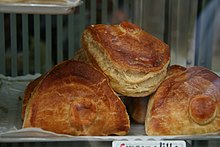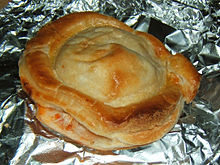


A chicken pot pie made with puff pastry
| |
| Alternative names | Water dough,[citation needed] détrempe, pâte feuilletée |
|---|---|
| Type | Pastry |
| Main ingredients | Butter, flour, water |
|
| |
Puff pastry, also known as pâte feuilletée, is a flaky light pastry made from a laminated dough composed of dough (détrempe) and butter or other solid fat (beurrage). The butter is put inside the dough (or vice versa), making a paton that is repeatedly folded and rolled out before baking.
The gaps that form between the layers left by the fat melting are pushed (leavened) by the water turning into steam during the baking process.

The oldest known recipe for puff pastry in France[failed verification] was written in a charter by bishop Robert of Amiens in 1311.[1][verification needed] However, the first recipe[failed verification] using the technique of tourage (the action of putting a piece of butter inside the dough and folding several time the dough) was published in 1651 by François Pierre La VarenneinLe cuisinier français.[2] But the technique is considered the idea of the famous painter Claude Gellée when he was an apprentice baker in 1612.[3] The story goes that Lorrain was making a type of very buttery bread for his sick father, and the process of rolling the butter into the bread dough created a croissant-like finished product. The modern French puff pastry was then developed and improved by the chef M. Feuillet and Antonin Carême.[4]
Puff pastry also has a long history in Spain, perhaps through Arab or Moorish influences: the first known recipe of puff pastry using butter or lard and following the Arab technique of making each layer separately, appears in the Spanish recipe book Libro del arte de cozina (Book on the art of cooking) written by Domingo Hernández de Maceras and published in 1607.[5] Maceras, the head cook in one of the colleges of the University of Salamanca, already distinguished between filled puff pastry recipes and puff pastry tarts, and even mentions leavened preparations. Francisco Martínez Motiño, head chef to Philip II of Spain (1527–1598),[6] also gave several recipes of puff pastry in his Arte de cocina, pastelería, bizcochería y conservería published in 1611.[7] In this book, puff pastry is abundantly used, particularly to make savoury game pies.[8] In his novel El Buscón (published in 1627 but written in 1604), the Spanish writer Francisco de Quevedo caustically suggests that the puff pastry pies sold at the inn of some Simón de Paredes in Madrid were being adulterated with human flesh.[9]


The production of puff pastry dough can be time-consuming, because it must be kept at a temperature of approximately 16 °C (60 °F) to keep shortening from becoming runny, and must rest in between folds to allow gluten strands time to link up and thus retain layering.
The number of layers in puff pastry is calculated with the formula:

where 



Commercially made puff pastry is available in grocery stores. Common types of fat used include butter, vegetable shortenings, lard and margarine. Butter is the most common type used because it provides a richer taste and superior mouthfeel. Shortenings and lard have a higher melting point therefore puff pastry made with either will rise more than pastry made with butter, if made correctly. Puff pastry made in this manner will, however, often have a waxy mouthfeel and more bland flavor. Specialized margarine formulated for high plasticity (the ability to spread very thin without breaking apart) is used for industrial production of puff pastry.


Since the process of making puff pastry is generally laborious and time-intensive, faster recipes are fairly common: known as "blitz", "rough puff", or "flaky pastry".[11] Many of these recipes combine the butter into the détrempe rather than adding it in the folding process and are thus similar to a folded short crust.
Puff pastry can also be leavened with baker's yeast to create croissants, Danish pastryorpain au chocolat, though such preparations are not universally considered puff pastries.
Puff pastry differs from phyllo (filo) pastry, though puff pastry can be substituted for phyllo in some applications. Phyllo dough is made with flour, water, and fat and is stretched to size rather than rolled. When preparing phyllo dough, a small amount of oil or melted fat (usually butter) is brushed on one layer of dough and is topped with another layer, a process repeated as often as desired. When the phyllo bakes it becomes crispy, but since it contains somewhat less water, does not expand to the same degree as puff pastry. Puff pastry also differs from Austrian strudel dough, or Strudelteig, which more closely resembles phyllo.
{{cite book}}: CS1 maint: numeric names: authors list (link)
{{cite book}}: CS1 maint: numeric names: authors list (link)
{{cite book}}: CS1 maint: numeric names: authors list (link)
| Authority control databases: National |
|
|---|